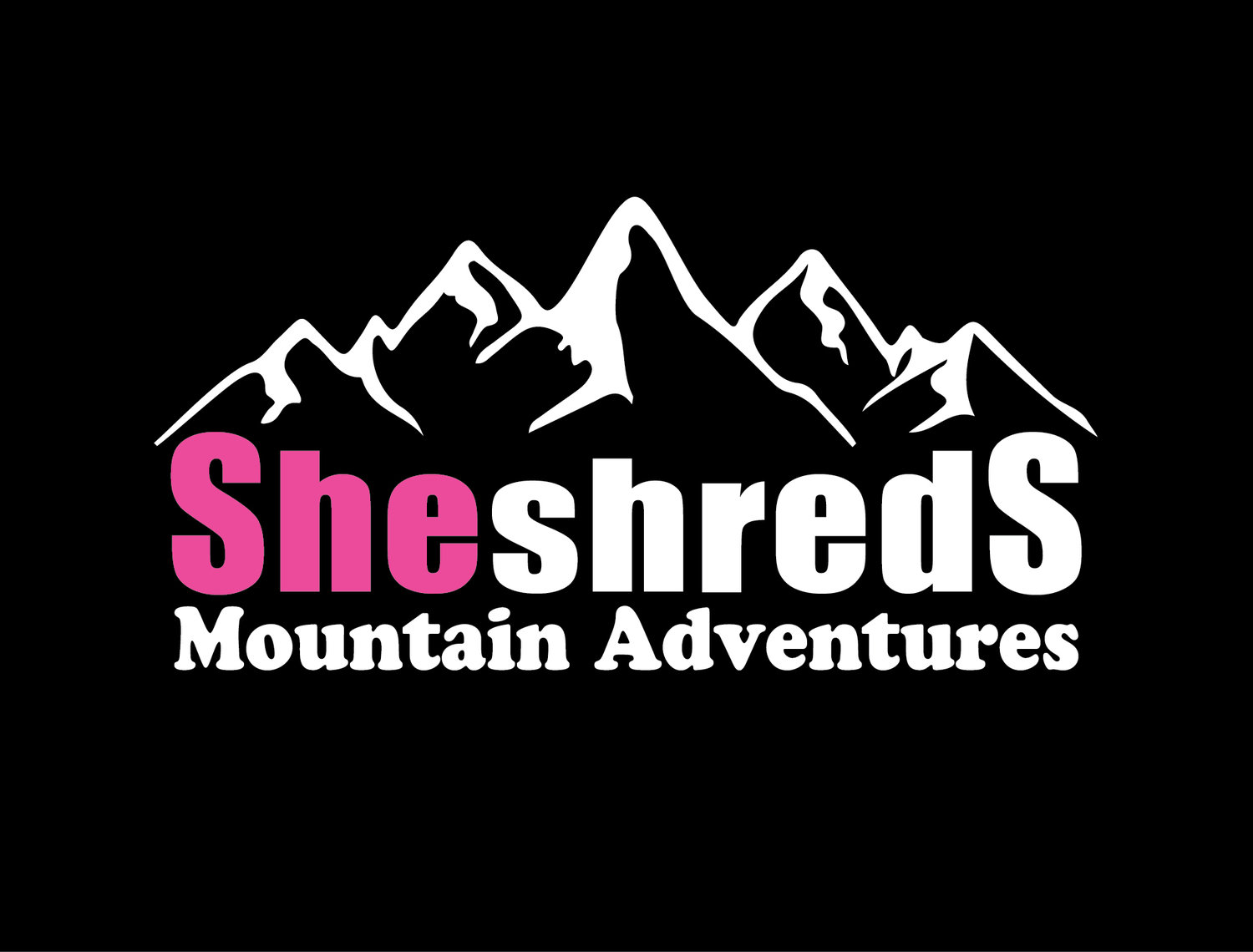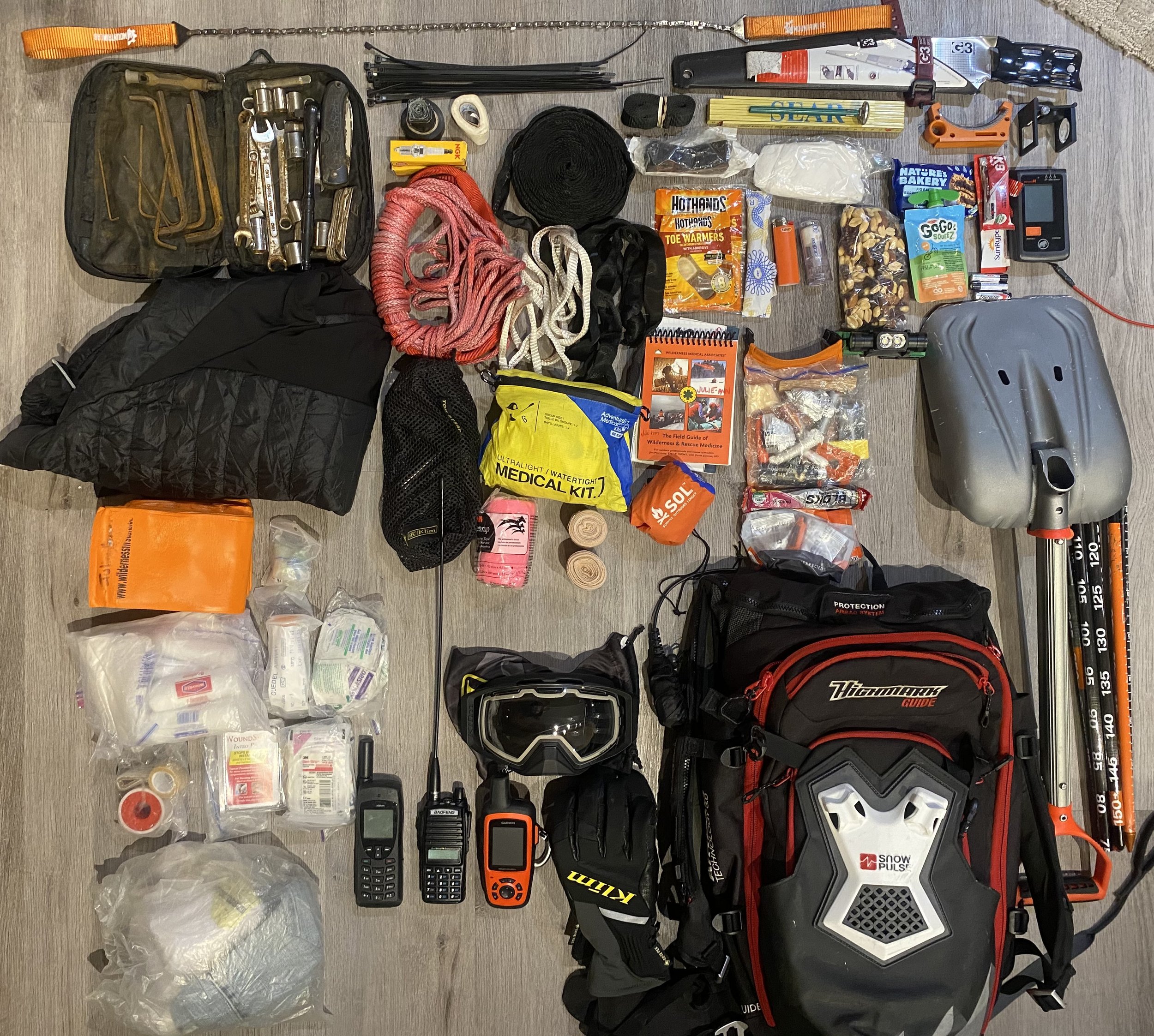To even think that people still snowmobile without wearing a pack still boggles my mind! Why are you depending on someone else to save you in any unfortunate circumstance if one were one to happen? In the She Shreds Mountain Adventures backcountry survival lessons, I always make sure to go over what everyone in the group has in their pack before we head out on an adventure, to make sure we are prepared for anything. I highly suggest doing this with your buddies that you regularly ride with.
“You’re out there on your own far from civilisation, be the most prepared you can be! It’s not a question of IF IT WILL HAPPEN, it’s a question of WHEN IT WILL HAPPEN. Think like this and you will be prepared for whatever the backcountry throws at you!” – Julie-Ann Chapman
Here is what I carry in my Klim Atlas avy pack and Polaris Lock & Ride tunnel bags…
Full first aid kit – Survive Outdoors Longer make amazing pre-packaged kits that you can add your own goodies to, its a great base to start with. Its suggested to carry everything from band aids, antiseptic wipes, compress dressings, splints, gauze, tourniquet, heavy bleeding pads, triangular wraps, trauma/accident report sheets, etc, etc. Make sure to keep all of this in a water resistant bag! And it wouldn’t hurt to take a first aid course so you know how to mend someone or keep someone stable while higher level of care arrives. The last thing they want is you trying to splint a broken bone if you don’t know how. You ask why would someone even attempt to touch someone with a broken limb? Well, because lets say you are very far from the trucks, you would want to make the limb immobile (make it the most comfy you can) for their ride down. You’re out there on your own far from civilisation, be the most prepared you can be!
The pack itself – 26L Klim Atlas avalanche pack. An avalanche pack shouldn’t change your decision making in the backcountry. Its just an extra blanket of safety if need be. You want to be careful how much weight you carry on your back. The Polaris Lock & Ride tunnel bags are amazing to carry all the extra stuff you dont want on our back.
inReach Explorer, Zoleo and Sat phones – two way communication SOS device that relates on iridium satellites. Incase you need a helicopter for a big bobo, or text your lover at home (when you’re out of cell range) to get dinner started, these little gems of devices are awesome. The inReach & Zoleo tracks you wherever you are in the world, allows you to communicate with people via text and email even when you are out of cell phone range, and if you call for SOS, your GPS coordinates are dispatched to the closest search and rescue in the surrounding area. The sat phone allows you to have a direct conversation if you need to request rescue gear brought to the scene (but sometimes looses the satellite so your call maybe dropped).
40-100+ft rope, pulleys & carabineers – for rescuing “your buddy” that thought the throttle was the break when he approached the crevasse really fast. Or that sled that broke down the slope and is impossible to tow out, so you have to set up a pulley system around a tree to pull the sled out. Here is a video to get the idea of this set up HERE (you don’t need a come-along like this one because you’ll likely have many people to help pull the rope downhill, so just a small pulley that can handle 500lbs weight and a crew of people pulling downhill allowing the sled to creep uphill).
Shovel & probe & transceiver– duh!! Wear the transceiver on your body, not in the pack! The shovel should be in your pack not on your tunnel for avalanche rescue purposes. Sure you can carry a second one on your tunnel of the sled for easy access when stuck.
Snowmobile tools – hose clamps, spare break leaver, shock pump (if you have air shocks), basic kit with wrenches, sockets, screwdrivers, zip ties, duct & electrical tape!
Survival kit – All hell breaks loose. You have to stay the night in the backcountry. I hope you are prepared! Survive Outdoors Longer make perfect survival kits to suit your every needs. Pack extra warm clothes/gloves, a tampon (to dip in your gas tank to ignite a fire), water resistant/strike anywhere matches, lighters (basically multiple ways to light a fire), flint, wood carving tool (knife), compass, mini fishing kit, whistle, flare, bivvy sack, wood saw, shelter kit/tarp, rope, small stove to be able to boil water… And make sure to keep all of this is a water resistant bag! I like to carry the majority of this stuff (the smaller lighter stuff) in my pack incase the snowmobile goers off a cliff or down a crevasse then you have all you need to survive on your pack.
Two way radios – You’re deep in the trees or over in the next drainage and you can’t find your buddy. “I’m out of gas, Do you copy Bobby Jo?”… “10-4 rubber ducky on my way with the jerry”.
VHF Radio - to communicate with outside world such as calling your turns on a logging road during active logging, or to assist with things such as heli evacuation.
Snow science tools – Snow saw, ruler, inclinometer, aluminium crystal card, thermometer, 10x loupe, field book (I call it my old lady diary, it’s the only book I write daily logs in). Always good to do your own research on what the snow is doing. I highly suggest taking an avalanche course that touches not only on companion rescue and transceiver work but also on snow studies/science. A course that will help you understand why avalanches happen. Avalanche Canada offers AST 1 & 2 to get you started on the right path. Doing a multiple day backcountry trip and don’t have access to the avy reports for days? It’s a must to have these tools to observe what the snow is doing over such a period of time.
Extra food and water – High calorie food, energy blocks.
A wood saw – We all go into trees! It’s so much easier to saw a branch off than to flip a 500lb machine that is all tangled in branches.
Head lamp – I’ve seen people smash their lights out on a tree and have to sled out in the dark with only their head lamp shining the way. Frankensled makes a great helmet lamp that attaches with a GoPro mount or Lynx OGT makes small high lumen headlamps.
Extra goggles/lenses– The worst is when your goggles are all fogged up and you can’t see where you’re going!
Extra fuel – Going on a long haul? Pack a jerry on your tunnel. Don’t be the kid that’s full pin all day and runs out of fuel first and uses everyone else’s fuel!! Every pack has a buddy like that!
An extra belt for the sled
One last thing – always find out if there is a safety cache near by with spine boards, etc. or a cabin you can make yourself a warm fire in.




